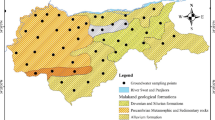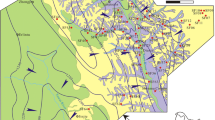Abstract
In this study, 63 groundwater samples were collected in the Kashgar Delta Area in Xinjiang in 2016, and then, the samples were tested and the test results were analyzed. Multivariate statistical techniques were used to determine the sources of pollution, and the USEPA (United States Environmental Protection Agency) model was used to assess the long-term health risk of groundwater to adults and children in the study area. The concentrations of groundwater chemical Na+, Cl−, SO42−, NH4+-N, TDS, F−, I−, As, Fe, Mn, Pb, Hg, pH, TH, and CODMn, which exceed the permissible level in the study based on groundwater quality index and possibly pose a potential threat to the health of the residents in the area, which are mainly influenced by geological conditions. The source of the pollutants is the dissolution of minerals in the aquifer medium, which is greatly affected by the high-salinity groundwater environment, pH conditions, redox conditions, and evaporation and concentration effect. The values of the noncarcinogenic health risk index HQn follow the descending order of Cl− > F− > As > Fe > Mn > Pb > Hg > NH4+-N; There are eight nonarcinogens and one carcinogen in groundwater of which Cl− is the dominant noncarcinogenic factor, while As is the main carcinogenic pollutant in the study area. The health risk ratio results show that Cl− and As are the main pollutants that pose the greatest threat to both adults’ and children’s health, and they should be considered as the primary indicators for health risk management and control.






Similar content being viewed by others
Data availability
The datasets generated during and/or analyzed during the current study are not publicly available due to [REASON(S) WHY DATA ARE NOT PUBLIC] but are available from the corresponding author on reasonable request.
References
Ahmad, T., Agus, E. J., Irwan, I., Takahiro, H., & Lambok, H. M. (2018). Controlling factors and driving mechanisms of nitrate contamination in groundwater system of Bandung Basin, Indonesia, deduced by combined use of stable isotope ratios, CFC age dating, and socioeconomic parameters. Water Research, 148(1), 292–305.
Bhowmick, S., Pramanik, S., Singh, P., Mondal, P., Chatterjee, D., & Nriagu, J. (2018). Arsenic in groundwater of West Bengal, India: A review of human health risks and assessment of possible intervention options. Science of the Total Environment, 612, 148–169.
Duan, L., Wang, W. K., Sun, Y. B., Zhang, C. C., & Sun, Y. Q. (2020). Hydrogeochemical characteristics and health effects of iodine in groundwater in Wei River Basin. Exposure and Health, 1–15.
Fabro, A. Y. R., Avila, J. G. P., Alberich, M. V. E. A., Sansores, S. A. C., & Camargo-Valero, M. A. (2015). Spatial distribution of nitrate health risk associated with groundwater use as drinking water in Merida, Mexico. Applied Geography, 65, 49–57.
Fan, W., Zhou, J. L., Zhou, Y. Z., Zeng, Y. Y., Chen, Y. F., & Sun, Y. (2020). Water quality and health risk assessment of shallow groundwater in the southern margin of the Tarim Basin in Xinjiang, PR China. Human and Ecological Risk Assessment: An International Journal, 1–21.
Gao, Y. Y., Qian, H., Wang, H. K., Chen, J., Ren, W. H., & Yang, F. X. (2020). Assessment of background levels and pollution sources for arsenic and fluoride in the phreatic and confined groundwater of Xi’an city, Shaanxi. China. Environmental Science and Pollution Research, 27(28), 34702–34714.
Gong, X., Chen, Z., & Luo, Z. (2014). Spatial distribution, temporal variation, and sources of heavy metal pollution in groundwater of a century-old nonferrous metal mining and smelting area in China. Environmental Monitoring & Assessment, 186(12), 9101.
Huan, H., Li, X., Zhou, J., Liu, W. J., Li, J., Liu, B., Xi, B. D., & Jiang, Y. H. (2020). Groundwater pollution early warning based on QTR model for regional risk management: a case study in Luoyang city, China. Environmental Pollution 259, 113900.
Koundouri, P. (2004). Current issues in the economics of groundwater resource management. Journal of Economic Surveys, 18(5), 703–740.
Kumar, M., Ramanatahn, A., Tripathi, R., Farswan, S., Kumar, D., & Bhattacharya, P. (2017). A study of trace element contamination using multivariate statistical techniques and health risk assessment in groundwater of Chhaprola Industrial Area, Gautam Buddha Nagar, Uttar Pradesh, India. Chemosphere, 166, 135–145.
Lal, K., Sehgal, M., Gupta, V., Sharma, A., John, O., Gummidi, B., Jha, V., & Kumari,A. (2020). Assessment of groundwater quality of CKDu affected Uddanam region in Srikakulam district and across Andhra Pradesh, India. Groundwater for Sustainable Development, 11, 100432.
Lima, M. L., Romanelli, A., Calderon, G., & Massone, H. (2019). Multi-criteria decision model for assessing groundwater pollution risk in the urban-rural interface of Mar del Plata City (Argentina). Environmental Monitoring and Assessment, 191(6), 347.
Li, P. Y., Wu, J. H., Qian, H., Lyu, X. S., & Liu, H. W. (2014). Origin and assessment of groundwater pollution and associated health risk: A case study in an industrial park, northwest China. Environmental Geochemistry and Health, 36(4), 693–712.
Li, B., Zeng, Y. F., Zhang, B. B., & Wang, X. Q. (2018). A risk evaluation model for karst groundwater pollution based on geographic information system and artificial neural network applications. Environmental Earth Sciences, 77(9), 1–14.
Lu, Y. L., Song, S., Wang, R. S., Liu, Z. Y., Meng, J., Sweetman, A. J., Jenkins, A., Ferrier, R. C., Li, H., Luo, W., & Wang, T. Y. (2015). Impacts of soil and water pollution on food safety and health risks in China. Environment International, 77, 5–15.
Ministry of Environmental Protection of China. (2013). Handbook of Chinese Population Exposure Parameters. China Environment Press (In Chinese).
Mohammad, M., & Nicola, C. (2015). Arsenic in drinking water, transition cell cancer and chronic cystitis in rural Bangladesh. International Journal of Environmental Research and Public Health, 12(11), 13739–13749.
Muhammas, S., Shah, M., & Khan, S. (2011). Health risk assessment of heavy metals and their source apportionmentin drinking water of Kohistan region, northern Pakistan. Microchemical Journal, 98(2), 334–343.
Nai, W. H, Shi, J., Wang, W. K., Wang, Y. X., Duan, L., & Li, B. (2018). Isotopic age characteristics and renewal rate of groundwater in Kashgar Plain. Xinjiang Geology, 36(3), 406–409 (In Chinese).
Nguyen, B. T., Nguyen, T., & Bach, Q. V. (2020). Assessment of groundwater quality based on principal component analysis and pollution source-based examination: A case study in Ho Chi Minh City. Vietnam. Environmental Monitoring and Assessment, 192(6), 395.
Ouedraogo, I., Defourny, P., & Vanclooster, M. (2015). Mapping the groundwater vulnerability for pollution at the pan African scale. Science of the Total Environment, 544, 939–953.
Radfard, M. M., Yunesian, M., Nodehi, R. N., Biglari, H., Nazmara, S., Hadi, M., Yousefi, N., Yousefi, M., Abbasnia, A., & Mahvi, A. H. (2018). Drinking water quality and arsenic health risk assessment in Sistan and Baluchestan, Southeastern Province. Iran. Human and Ecological Risk Assessment: An International Journal, 25(4), 946–964.
Rezaei, A., Hassani, H., & Jabbari, N. (2019). Evaluation of groundwater quality and assessment of pollution indices for heavy metals in North of Isfahan Province. Iran. Sustainable Water Resources Management, 5(2), 491–512.
Saleh, H. N., Panahande, M., Yousefi, M., Asghari, F. B., Conti, G. O., Talaee, E., & Mohammadi, A. A. (2019). Carcinogenic and non-carcinogenic risk assessment of heavy metals in groundwater wells in NeyshaburPlain. Iran. Biological Trace Element Research, 190(1), 251–261.
Singha, S. S., Pasupuleti, S., Singha, S., Singh, R., & Venkatesh, A. S. (2019). A Gis-based modified drastic approach for geospatial modeling of groundwater vulnerability and pollution risk mapping in Korba District. Central India. Environmental Earth Sciences, 78(21), 1–19.
Su, C., Zhang, F. G., Cui, X. S., Cheng, Z. S., & Zheng, Z. X. (2020). Source characterization of nitrate in groundwater using hydrogeochemical and multivariate statistical analysis in the Muling-Xingkai Plain. Northeast China. Environmental Monitoring and Assessment, 192(7), 456.
Wei, X., Zhou, J. L., Nai, W. H., Zeng, Y. Y., Fan, W., & Li, B. (2019). Hydrochemical characteristics and evolution of groundwater in the Kashgar Delta Area in Xinjiang. Environmental Science, 40(9), 4042–4051 (In Chinese).
WHO. (2011). Guidelines for Drinking Water Quality 4th Edn. Available online:http://whqlibdoc.who.int/publications/2011/9789241548151_eng.pdf (accessed on 31 March 2013).
Yu, J. W., Zhou, J. L., Long, A. H., He, X. L., Deng, X. Y., & Chen, Y. F. (2019). A comparative study of water quality and human health risk assessment in longevity area and adjacent non-longevity area. International Journal of Environmental Research and Public Health, 16(19), 3737.
Zeng, Y. Y., Zhou, J. L., Zhou, Y. Z., & Jia, R. L. (2016a). Assessment and causes of groundwater organic pollution in typical plain areas in Xinjiang, China. Exposure and Health, 8, 401–417.
Zeng, Y. Y., Zhou, Y. Z., Zhou, J. L., Jia, R. L., Gao, Y. X., & Fan, W. (2016b) Assessment of groundwater quality status in western Kashgar, Xinjiang. Journal of Xinjaing Agricultural University, 39(2), 167–172 (In Chinese).
Zhou, Y. H., Ning, J., Li, L. X., Long, Q., Wei, A. H., & Liu, Z. (2020). Health risk assessment of groundwater in Gaobeidian, North China: distribution, source, and chemical species of the main contaminants. Exposure and Health, 1–20.
Zhou, Y. Z., Zeng, Y. Y., Zhou, J. L., Guo, H. M., Li, Q., Jia, R. L., Chen, Y. F., & Zhao, J. T. (2017). Distribution of groundwater arsenic in Xinjiang, P.R. China. Applied Geochemistry, 77, 116–125.
Zuo, Q. T., Han, C. H., Ma, J. X., & Liu J. (2017). Water resources characteristics and supporting capacity for “the Belt and Road” in China mainland. Journal of hydraulic engineering, 48(6), 631–639 (In Chinese).
Acknowledgements
The research was supported by the National Natural Science Foundation of China “Migration and enrichment mechanism of iodine in high iodine groundwater system in oasis zone of Tarim basin” (42067035), Natural Science Foundation project of Education Department of Xinjiang Uygur Autonomous Region “Study on the mechanism of salinization and desalination of confined water in the plains of the Kashgar River Basin, Xinjiang” (XJEDU2018Y020), the Natural Science Foundation Project of Xinjiang Uygur Autonomous Region “Research on the Formation Mechanism of High Sulphate Groundwater in Xinjiang Kashgar River Basin” (2019D01B18), and Water Conservancy Engineering Key Discipline Project of Xinjiang Agricultural University “Formation Mechanism of High Iodine Groundwater in the Kashgar River Basin, Xinjiang” (SLXK2019-10).
Author information
Authors and Affiliations
Additional information
Publisher's Note
Springer Nature remains neutral with regard to jurisdictional claims in published maps and institutional affiliations.
Rights and permissions
About this article
Cite this article
Yu, D., Zhou, J., Aikelamu, A. et al. Source analysis and health risk assessment of groundwater pollution based on multivariate statistical techniques in Kashgar Delta Area, Xinjiang, China. Environ Monit Assess 193, 805 (2021). https://doi.org/10.1007/s10661-021-09517-w
Received:
Accepted:
Published:
DOI: https://doi.org/10.1007/s10661-021-09517-w




